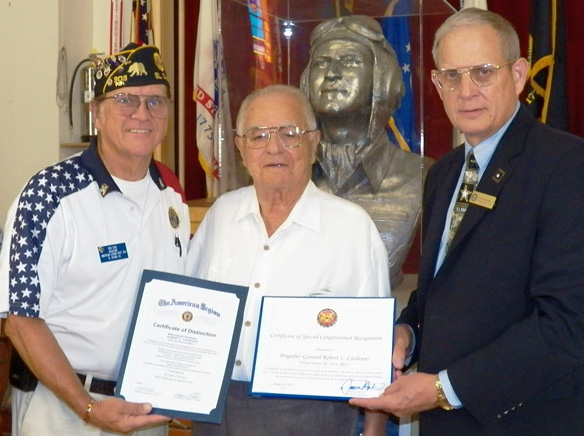Brig. Gen, Robert L. Cardenas, US Air Force retired, is a legend in his own time. And that created a problem.
“I kind of cut my own throat,” said Cardenas referring to his support for a policy barring memorials for anyone alive at Miramar National Cemetery. The Balboa Park Committee has a similarly restrictive standard, reserving public monuments and statues for figures of “significance” in San Diego’s history.
Brig. Gen, Robert L. Cardenas, US Air Force retired, is a legend in his own time. And that created a problem.
“I kind of cut my own throat,” said Cardenas referring to his support for a policy barring memorials for anyone alive at Miramar National Cemetery. The Balboa Park Committee has a similarly restrictive standard, reserving public monuments and statues for figures of “significance” in San Diego’s history.
A recently unveiled bust of Cardenas therefore rests for a time in a place of high honor in the Veterans Museum and Memorial Center in Balboa Park. Now 94 years old, he is a Legionnaire belonging to The American Legion’s El Cajon Post 303. Cardenas was honored on Aug. 23 at the meeting of the United Veterans Council of San Diego County, in front of the Bob Cardenas Monument. The inscription describes Cardenas as “Pioneering Aviator, Visionary Leader, Dedicated Patriot.”
El Cajon Post 303 Adjutant Rob Tade presented Cardenas a Certificate of Distinction, for his many military-career accomplishments and his service in retirement on behalf of establishing the Miramar National Cemetery. Wes Schermann, Post 303’s Second Vice Commander, appeared as representative of Congressman Duncan D. Hunter, who sent a Certificate of Special Congressional Recognition. Cardenas flew more than 80 aircraft and served during campaigns spanning World War II through the Cold War.
Cardenas was instrumental in bringing the United States Air Force into the jet age and then into space age. In popular history, he is renowned for flying the plane that launched the first supersonic flight breaking the sound barrier. Among military aviators, Cardenas is beloved for piloting the B-24 during World War II.
Cardenas has that period of his life on his mind these days. The Swiss Air Force celebrated its 100th anniversary on Aug. 31. They invited the general for an all-expenses-paid trip to help them celebrate the fact that while interned he checked out Swiss pilots in B-24’s and B-17’s.
“Due to age and health, I declined but sent them a video,” he said. “I was the command pilot leading the bomber formation on my 20th combat mission aboard the B-24 Sack Artists. Heavy flack and cannon fire from the ME-262 fighters shot us down.”
The B-24 started going down over the Bodensee, also called Lake Constance. Cardenas directed his co-pilot to head toward Switzerland as he entered the bomb bay to shred maps and classified documents. An explosion blew Cardenas out of the plane and serendipitously opened his parachute although ripping two chute panels. He drifted rapidly down onto the German side of the lakeshore, with German trucks advancing toward his position. Cardenas recalled swimming the La Jolla Three-Mile Rough Water Swim as a teenager, so he set out across the lake. The water was cold and not as buoyant as salt water, but a Swiss fisherman who took him aboard and got him to Switzerland rescued Cardenas.
The plane crash site is in Switzerland. The Swiss made it a memorial.
Cardenas stayed on assignment in Switzerland, to assist with repairs to 30 damaged planes, and then serve as a test pilot and trainer so that Swiss pilots could fly the planes to mountain airports. Once he had completed this task, Cardenas escaped from Switzerland with help from the French Underground. He then headed back to Wright Field to test new jet aircraft.
“That is why the B-24 bronze model is in the reflecting pool at the Veterans Memorial Garden,” Cardenas said. “And that is where my statue will be placed.”














